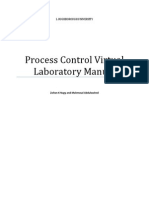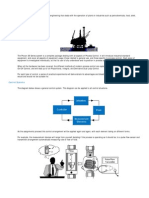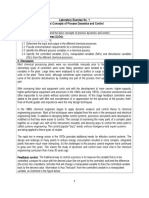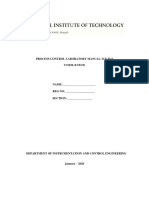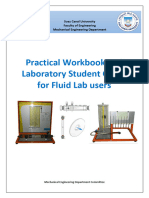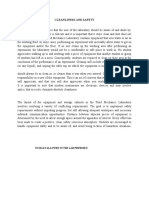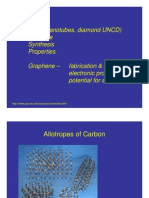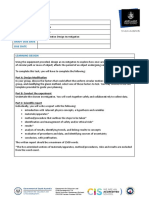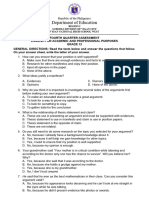PH Systems
PH Systems
Uploaded by
lux0008Copyright:
Available Formats
PH Systems
PH Systems
Uploaded by
lux0008Original Description:
Original Title
Copyright
Available Formats
Share this document
Did you find this document useful?
Is this content inappropriate?
Copyright:
Available Formats
PH Systems
PH Systems
Uploaded by
lux0008Copyright:
Available Formats
ChE 4L02
Process Control Laboratory
pH SYSTEMS
FALL 2005
CONTENTS
I. Laboratory Relevance and Goals
II. Preparation Prior to the First Laboratory
III. Safety and Equipment
IV. Start-up and Shut-down Procedures
V. Preliminary Tasks
VI. Process Modeling and Control
A. Empirical Model Identification and Pressure Control
B. Empirical Model Identification and Flow Control
C. pH Control
D. Self-Directed Learning
E. Summary Report
VII. Major Laboratory Tasks and Schedule
Resources
References
Laboratory Relevance and Goals
The pH of liquids affects important process phenomena, such as reaction rates,
vapor-liquid equilibrium, and corrosivity. In addition, the instrumentation used in
the laboratory demonstrates a range of typical control equipment. Therefore, you
will gain useful experience in process control by working with this equipment. In
addition, the required tasks for this laboratory enable you to apply principles and
practice that you learned in your process control course to a real (not simulated)
physical process.
This laboratory has the following goals, which are in addition to the general goals
presented in the course outline.
Understand instrumentation in typical control loops
Perform empirical modeling of pH dynamics and its controller tuning for a
complex cascade and multi-loop system.
Gain experience with digital equipment for implementing the PID feedback
algorithm
Define and perform a Self-Directed Learning investigation
1. Preparation Prior to the First Laboratory Session
To make the best use of your time in the laboratory, you will need to prepare before
the first session. This laboratory involves the following technologies and equipment.
Principles of pH
Empirical modeling of pH dynamics
Feedback control using a proportional-integral-derivative (PID) controller in
single-loop and cascade control
Measuring pressure, flow and pH
Manipulating the opening of a control valve
You should (1) read this document thoroughly and (2) review material on the topics
highlighted above. You should review/ learn the process reaction curve method and
a statistical-based parameter estimation method, since you will use both in this
laboratory. Your group can share the responsibility for learning these topics and
teaching all other members of the group.
Before the first laboratory session, you will be asked some preliminary
questions to test your preparation. This test will be included as an
individual lab-performance in the preliminary report.
2. Safety and Equipment
Before you begin performing experiments, you need to understand the equipment
and how to operate it safely. To assist you, a schematic is given in Figure 1; please
note that this schematic is far too simple to serve as a piping and instrumentation
drawing. You should begin your first session by performing the following tasks.
A. Safety
Learn the safety procedures from the TA, ask questions, and complete the safety
form when you are convinced that you can operate the equipment safely and know
how to respond to likely emergencies. Note that eye protection is required in the
laboratory.
B. Process equipment
The TA will explain the basic equipment involved in the laboratory. It is your
responsibility to understand all equipment, i.e., be able to explain the purpose and
physical principles for every element in the equipment. During the first session, you
must collect information and prepare a sketch of the equipment.
C. Control Station
A LabVIEW-based computer control has been developed for this experiment. You
just turn on the computer and double click the pH labViews icon so that the
following diagram will appear in your computers monitor. The TA will explain the
main function of this station.
You are required to provide a piping and instrumentation (P&I) diagram of the
laboratory equipment in your report. Each group needs to prepare only one
drawing; a copy of this drawing must appear in the reports from each group
members.
The drawing should include the process from the feed tanks to the effluent drain.
See Austin (1979), Weaver (1986) and Woods (1995) for examples of these drawings.
D. Control equipment
Sensors, displays, valves, and control calculation equipment are essential for
automatic process control. You should thoroughly understand this equipment. As
background, you can refer to the discussion of the feedback control loop elements
given in Chapter 7 of Marlin (2000) and much more detail provided in Andrew and
Williams (1979-1982).
The digital controller is based on the following continuous PID formulation.
I
dt
t dCV
T dt E t E
T
t E K K t MV
t
f
d
I
c sense
+
,
_
0
) (
' ) ( ) ' (
1
) ( ) (
with
E(t) = SP(t) CVf(t)
CVf(t) = The filtered value of the measured variable. The filter time
constants are quite fast, so that the effect is about 1-2 seconds of
filtering.
Ksense = determines the sign of the feedback; this is determined by the
direct (reverse) acting switch. (See Marlin (2000), Chapter 12)
KC = the controller gain. This must be positive. The units are
controller output/ CV in engineering units.
TI = the integral time (minutes)
Td = the derivative time (minutes)
MV(t) = the controller output in units of (1) 0-100% if sent to a valve or
(2) the secondary CV range if sent to a secondary in cascade.
The integral mode differs from the standard algorithm by the term (E), which is
unique to the LabView software. The term is defined in the following equation.
1
]
1
+
range
2
2
SP
) t ( E
1
1
) E ( with SPrange = Spmax SPmin
This term has the effect of reducing the integral mode when the error is large.
The controller is executed at a constant period of 1 second. Since this is very fast, the
controller functions essentially as a continuous controller.
Also, the data is stored at a period of 1 second. You must remember to begin data
storage before an experiment. Should you decide that the data is worthwhile, you
can store in on the disk. Later, you will be able to import the data into Excel for
plotting and calculations.
You will operate the equipment using the displays provided by the LabView
software. You have an overview display that enables you to observe all key process
variables and make most required changes to process operation. In addition, you
have a separate display for every controller; you can change controller parameters,
such as tuning constants, using these screens.
3. Start-up and Shut-down Procedures
The TA will instruct you on how to startup and shutdown the equipment. The
procedures are summarized in Tables 1 and 2. Please be sure that you understand
these instructions.
Table 1. Instructions for Starting up the pH Experiment.
1. Verify that both feed tanks contain sufficient liquid for the duration of the experiment, which
is 50L of acid and 100L of base.
2. Verify that the water inlet valves and the drain outlet valves to/from the feed tanks are
closed.
3. Open the valve on the instrument airline at the back of the equipment.
4. Open the water valve to dilute the effluent as it enters the drain.
5. Switch on the power to the experimental equipment; the orange LED will light up.
6. Open the pH Control program by double clicking the pH Control.exe icon on the desktop.
The program will load and begin to run. There is no reason to stop the program at any
time during the experiment.
7. Perform a 3-point calibration on the pH sensor using the buffer solutions provided.
8. Set both Bronco II DC drives, which control the pump speeds, on manual and stop
modes. Set the dials to about 50%. These are located at the top of the equipment panel.
9. Make sure all controllers are in the manual mode (OFF).
10. Make changes to the valve positions to ensure they are working properly by changing the
controller outputs (both FCs and both VCs) in manual and observing the stem
positions; then, set them all to 50%.
11. Flip the switch on one of the Bronco II drives from stop to start (the switch must be held
up until the pump starts spinning). When the pump is running, flip the manual switch
to automatic, at which point the pump will stop. Repeat for the other pump.
12. After determining the controller parameter, switch the pressure controllers to automatic or
on, and enter the desired set point values for each (see Table 3). Allow them to
achieve steady state.
13. Adjust the acid and base large control valves (VCs outputs) to achieve nearly the desired
flow rates.
14. Close the bottom outlet valves on both tanks, and close the valve on the second
neutralization tank about halfway, so the liquid level is high enough for the probe to be
inserted. Turn on the mixers once the liquid level is at least 1 inch.
15. Clean off the pH probe with distilled water and insert it into the second tank.
16. Manually adjust both large valves (VC outputs) until you are close to the desired flows.
Then, switch both flow controllers into automatic.
Table 2. Instructions for Shutting Down the pH Experiment.
1. Place all controllers in manual or off
2. Set the pressure controller outputs (motor speeds) to zero percent.
3. After the pressures have decreased, close the acid and base large and small control
valves.
4. Switch the pumps off
5. Turn off the tank mixers.
6. Open the bottom outlet valves from both neutralization tanks.
7. Close the instrument air valve.
8. Close the water dilution valve to drain.
9. Remove the pH probe and place it in its storage medium.
10. Exit the LabView program using the x in the top right corner of the window, and turn
off the display.
11. Turn off the power to the experimental equipment; the orange LED with go off.
12. Clean the areas around the computer and experimental equipment.
4. Preliminary Tasks
One of your important learning goals is to understand all elements in a control loop.
Control equipment is not perfect, so that you should understand its actual behavior
and how the behavior influences the dynamic performance of control systems. In
this section, you will investigate the behavior of individual elements before you
consider the integrated control loop. To answer these questions, you will have to
review the equipment carefully, locate information in references, and perform
simple empirical tests.
A. Control valve Answer the following question about the control valve that
can be manipulated by the feedback controller.
1. What type of valve body (globe, ball, diaphragm, etc.) is used for the large
acid? Is this a good choice?
2. How much stiction and hysteresis exists in the large acid valve
performance?
3. Describe the dynamic response of the large acid valve.
4. The acid flow is influenced by two valves, large and small. What is the
advantage of this approach? Why is it especially advantageous for pH
control?
B. The pH measurement.
1. What is the physical principle of the sensor? What reproducibility and
accuracy should we expect?
2. Where is the sensor located? Discuss the advantages and disadvantages
for this location.
C. Flow Measurement
Acid and base flows are measured for use in flow controllers.
1. The acid and base flows are measured by sensors using different
principles. Describe the principles for each.
2. Which sensor do we expect to provide better accuracy? What is the
expected accuracy of each? What is the cost for each?
You are required to provide written answers to these questions during the
lab session. These answers should be included in your preliminary report.
5. Process Modeling and Control
The goal of this laboratory is to develop a control system to maintain the effluent pH
near its set point. The typical operating conditions in the process are given in Table
3. The flow of the base represents the product stream that must be neutralized; you
are not allowed to adjust this stream to achieve pH control. The acid flow is the
utility stream that can be adjusted to achieve pH control.
When you have completed the startup procedure, the process will be in operation
near the desired conditions in Table 3. All automatic control will be off or in
manual, and the data storage will be off.
You will perform typical tasks to
i. Determine the dynamic behavior of the system and tune the pressure
controller,
ii. Determine the dynamic behavior of the system and tune the flow controller
iii. Implement pH control, and
iv. Perform a self-directed study proposed by your group and accepted by the
instructor.
However, chemical engineers should always apply their process knowledge when
involved in process operations and control. Therefore, you should review the
principles of the pH process before beginning this experiment.
A. Empirical Model Identification and Pressure Control
Engineers use models, either qualitative or quantitative, for nearly every task in
plant design and operation. Since fundamental models are time consuming to
develop and require data that might not be available, we often build models based
Table 3. Typical operating conditions for the pH Experiment
Measurement Controller output
Acid Pressure, P1 6 psig Acid pump 50%
Base Pressure, P2 3 psig Base Pump 80%
Acid flow, F1 ~100 mL/min Acid valves large 20%
small 50%
Base flow, F2 ~250 mL/min Base valves large 55%
Small 50%
on experimental data; these are termed empirical models. You should review/ learn
the process reaction curve, since you will use it in this laboratory. When performing
these experiments, manipulate the valve using the PC-based LabView system;
observe the results on the screen graphs, and save worthwhile data for later use.
1. For each flow system, determine the models between the pump speed and
pressure using the process reaction curve method.
a. Design the experiment and justify the design
b. Perform the design and evaluate the data (review 3P03 for data
evaluation)
c. Estimate the model parameters and discuss the accuracy of your results
2. For each flow system, tune the feedback controller.
a. Calculate the tuning constants
b. Implement, test, and fine tune
Important Data storage
You can observe the dynamic responses on the real-time screen plots provided by the LabView
program. However, you cannot plot these directly or manipulate the data for calculations.
Therefore, we have provided the ability to save data to a file. Please remember to follow the
following instructions.
1. The data storage is initially off and will not store data until you take action
2. You can begin to store data by changing the save data switch to ON. (You should
not leave this on at all times, because you will store a very large file and you will not
be able to easily find the relevant data.)
3. After you have completed an experiment, you can stop saving data. The program will
prompt you to store the data. If you believe that the data will be useful, save the data.
We recommend that you use the .xls extension, so that the data in saved as an Excel
spreadsheet.
4. Be sure to give the file a meaningful name so that you distinguish the data from
different experiments.
5. Do not run any other programs at the same time that you are running LabView. You
can copy to a floppy if you want to use the file in Excel during the lab period.
6. You can open the Excel file and plot and perform calculations. When you save the file
after modification, BE SURE to save as an Excel spreadsheet this will require you to
change the default Save as type!
7. You should not include the data listings in your lab report. However, you must retain
the data in case the instructor has questions.
B. Empirical Model Identification and Flow Control
For each flow system, determine the models between the small valve and the flow,
and tune the flow controller using the same method as in (1) and (2) above.
C. pH Control
After parts A and B, we have stabilized the flows, but we have no automatic control
of the effluent pH. In this laboratory, you will implement a feedback controller to
control pH by manipulating the acid flow rate. This is a cascade design! (Its time to review
cascade control if its a little fuzzy after the summer.)
1. Discuss advantages for the cascade design.
2. Perform a process reaction curve experiments at several ranges of the effluent pH, e.g., 4,
5.5, 7, 8.5 and 10. Why would we want to investigate various operating conditions?
Compare your results with the theoretical titration curve.
3. Calculate the tuning at three conditions and explain differences.
4. Implement the pH controller and evaluate the dynamic performance for the following
changes.
5. A set point change of 0.50 pH units.
6. A change in the base flow rate of -30 liters per minute.
7. Discuss strengths and weaknesses of the control system that you have designed. These
issues should provide some ideas for the SDL exercise.
D. Self-Directed Learning
In this section, you will define a knowledge-based learning goal that is related to
this laboratory. By knowledge-based, we mean a goal directed to improving your
understanding of process dynamics and control technology (not group skills,
communication skills, etc.).
Your plan should include a program of investigation to achieve the goal. The
program can include experimental, theoretical, and literature tasks; it must include
some experimentation. Prepare a clear and concise explanation of your goal and the
program for investigation.
You must submit your proposed SDL goal to the instructor or TA for
approval before you begin the third week of your lab. The explanation must
be presented in the preliminary report, if not discussed and approved
earlier.
In your final laboratory report, briefly explain why you selected these goals and how
you designed the experimental program, as well as specific conclusions based on the
investigations.
E. Summary Report
3. Major Laboratory Tasks and Schedule
Guidance on the key tasks and when they should be completed is given in Table 4.
Students can rearrange some of the tasks; however, the graded activities cannot be
rescheduled. Students are encouraged to discuss topics with the TA and instructor
at any time. They can propose their SDL project before the second session, if they
want.
Table 3. Guidance for the stirred tank heater laboratory
Timing Un-graded activity Graded activity Tasks by
completion
Before 1st session Read Laboratory
documentation (*)
Review relevant
technology (**)
1
st
session Safety training
Equipment
orientation
Answers to the
questions in this
module
Sketch of P&ID
diagram of the
equipment
Collect data for
dynamic models
Between 1
st
and 2
nd
Calculate model
parameters
Complete P&I
Drawing
2
nd
session Mid-lab review
meeting
Identify a list of
SDL tasks
Controller tuning
Data analysis
Draft for
preliminary
report
3
rd
session Do your SDL task Data analysis
Complete SDL
task
Two weeks after 3
rd
session
Submit final
report
Note:
One week after the second week of each your Lab session, you must submit
a preliminary report that summarizes your experiment design, collected data
and answers to the assigned questions. The report together with the
proposed SDL experiment design is submitted to the TA and will count for
10% of your laboratory grade.
* Cover understanding of this document, relevant theory, and initial experimental plan
** Cover equipment principles, theory, and initial results from modeling experiments
Resources
The basic references for this laboratory are given in the References section of this
document. As you encounter questions during the laboratory, you will need to
gather information from other published material in the library, on the WEB, and
from suppliers of industrial control equipment. Naturally, you are encouraged to
ask questions of the TA and instructor, but you will be expected to search and find
information available in public references.
References
Andrew, W. and H. Williams, Applied Instrumentation in the Process Industries, Gulf
Publishing, Houston, Volume I, 1979; Volume II, 1980; Volume III, 1982.
Austin, D., Chemical Engineering Drawing Symbols, Halsted Press, London, 1979.
Hough, M., E. Wood, and T. Marlin, Instrumentation Principles, available at
www.pc-education.mcmaster.ca (March 2001).
Hoyle, D., Designing for pH Control, Chemical Engineering, p. 121, November 8, 1976.
Marlin, T., Process Control (2
nd
Edition), McGraw-Hill, New York, 2000.
(or, Marlin, T., Process Control (1
st
Edition), McGraw-Hill, New York, 1995)
McMillan, G., pH Control, A Magical Mystery Tour, InTech, 69-76, Sept. 1984.
Vendors, Notebook on laboratory equipment available in laboratory room (Do not
remove!).
Weaver, R., Process Piping Drafting (3
rd
Edition), Gulf Publishing, Houston, 1986.
Woods, D., Process Design and Engineering Practice, Prentice Hall, Englewood Cliffs,
1995.
You might also like
- Business Research Method Question and AnswersDocument16 pagesBusiness Research Method Question and AnswersEthiria Cera Faith75% (12)
- FINAL - CSEC Biology Lab Manual 2022-2024 STUDENT VERSIONDocument48 pagesFINAL - CSEC Biology Lab Manual 2022-2024 STUDENT VERSIONchristismithja100% (1)
- DEN5200 CONTROL SYSTEMS ANLAYSIS AND DESIGN ReportDocument15 pagesDEN5200 CONTROL SYSTEMS ANLAYSIS AND DESIGN Reportsilvia100% (1)
- PLC Full ReportDocument10 pagesPLC Full ReportJian Jie0% (1)
- Empirical Formula For Magnesium OxideDocument6 pagesEmpirical Formula For Magnesium Oxidesophia100% (1)
- Introduction To Process InstrumentationDocument15 pagesIntroduction To Process Instrumentationtaufikrezza850% (1)
- Instruction Sheet Process Trainer 37 100Document4 pagesInstruction Sheet Process Trainer 37 100Abcd123411No ratings yet
- PPC Coursework Jan 2019Document2 pagesPPC Coursework Jan 2019KongWeiHernNo ratings yet
- Team 4 Final PresentationDocument25 pagesTeam 4 Final Presentationlux0008No ratings yet
- Lab Manual Fall 2017Document68 pagesLab Manual Fall 2017Nil SabbirNo ratings yet
- Summative Test 1.0Document2 pagesSummative Test 1.0Santisas Zai100% (2)
- Palmers Law of Life 1958Document166 pagesPalmers Law of Life 1958JackharlessdcNo ratings yet
- Uniben Part Time Past Questions - Free Download PDFDocument5 pagesUniben Part Time Past Questions - Free Download PDFCharles Obaleagbon100% (1)
- DNA Experiments by Gregg BradenDocument4 pagesDNA Experiments by Gregg BradenMihaela Ava100% (9)
- PH ControlDocument10 pagesPH Controllux0008No ratings yet
- Lab Session 1 Exp 9: Simple PID Flow Control (FIC-413 - POS) Students' ManualDocument19 pagesLab Session 1 Exp 9: Simple PID Flow Control (FIC-413 - POS) Students' ManualFelicia ChiewNo ratings yet
- M08-PID Control LoopDocument131 pagesM08-PID Control Loopngirma241No ratings yet
- Instrumentation and Control Familiarization With EDIBON Process Control SystemDocument5 pagesInstrumentation and Control Familiarization With EDIBON Process Control SystemJc UyNo ratings yet
- MEC 412 Experiment 4 Lab ManualDocument5 pagesMEC 412 Experiment 4 Lab ManualAnas OmarNo ratings yet
- Distillation Dynamics and Control Workbook 2006 PDFDocument18 pagesDistillation Dynamics and Control Workbook 2006 PDFEr Mayur PatilNo ratings yet
- Aim of The ExperimentDocument10 pagesAim of The Experimentadssf fdgddNo ratings yet
- Expt. 4 - Pressure ControlDocument16 pagesExpt. 4 - Pressure Controlpleco4meNo ratings yet
- Lab 1a Wind Tunnel Testing Principles & Drag Coefficients of Golf BallsDocument9 pagesLab 1a Wind Tunnel Testing Principles & Drag Coefficients of Golf BallsSaadNo ratings yet
- PCVLDocument16 pagesPCVLabmuqeet2No ratings yet
- LabExercise 9 - Dynamic Systems SimulationDocument16 pagesLabExercise 9 - Dynamic Systems SimulationQueenie Rose PercilNo ratings yet
- Control Lab Project ReportDocument28 pagesControl Lab Project ReportDanyal QamarNo ratings yet
- Oil & Gas Separation Book 2 PDFDocument47 pagesOil & Gas Separation Book 2 PDFMahathir Che Ap100% (4)
- The Structure of Control System of GLP Animal LaboratoryDocument6 pagesThe Structure of Control System of GLP Animal Laboratoryviet_ha04No ratings yet
- Report ControlDocument33 pagesReport Controlajwadalfatani100% (5)
- Chen4352 PDC Lab ManualDocument26 pagesChen4352 PDC Lab ManualmohammedNo ratings yet
- INST-U01 Trainers Resource MaterialDocument16 pagesINST-U01 Trainers Resource MaterialkhalafNo ratings yet
- Lab ReportDocument13 pagesLab ReportHemal MenukaNo ratings yet
- Lectures Process ControlDocument98 pagesLectures Process Controlrizzagorospe100% (1)
- ECNG3004 Control System ApplicationsDocument7 pagesECNG3004 Control System ApplicationsMarlon BoucaudNo ratings yet
- اخررررر تعديلDocument10 pagesاخررررر تعديلAhmed nawfalNo ratings yet
- Control Exp RohitDocument9 pagesControl Exp RohitrohitNo ratings yet
- Tutorial Sol CH 1Document5 pagesTutorial Sol CH 1Nabila Agnasia DesmaraNo ratings yet
- 01 problems and solutionsDocument5 pages01 problems and solutionsManish GoyalNo ratings yet
- Closed-Loop System Marlin 2002Document24 pagesClosed-Loop System Marlin 2002Debora Fitriyana SitorusNo ratings yet
- Chapter 3 Process SimulationDocument19 pagesChapter 3 Process SimulationYang Yew Ren100% (1)
- 01 Basic Concepts of Process Dynamics and ControlDocument13 pages01 Basic Concepts of Process Dynamics and Controldr. rickNo ratings yet
- PC Lab ManualDocument47 pagesPC Lab ManualAoiNo ratings yet
- Controller TuningDocument17 pagesController TuningtrshaaaNo ratings yet
- EngM513 LAB Manual Automatic Control EngineeringDocument23 pagesEngM513 LAB Manual Automatic Control Engineeringlacika04No ratings yet
- Temperature Control LabDocument16 pagesTemperature Control Labhoocheeleong234100% (1)
- Control Lab Manual-2021Document63 pagesControl Lab Manual-2021asmaa abu haniNo ratings yet
- Lab 6 Engineering Measurement and Lab SampleDocument11 pagesLab 6 Engineering Measurement and Lab Sampletk_atiqahNo ratings yet
- C7 Temperature Control ExperimentDocument5 pagesC7 Temperature Control ExperimentSzeQiLungNo ratings yet
- Flowrate and Pressure ControlDocument13 pagesFlowrate and Pressure ControlBarnabas YohannesNo ratings yet
- Daytona Operator Training Manual v1 PDFDocument33 pagesDaytona Operator Training Manual v1 PDFjose_mario1128No ratings yet
- Practices Manual: 7.1 General Description of The SystemDocument18 pagesPractices Manual: 7.1 General Description of The SystemAdjie PranatamaNo ratings yet
- Practices Manual: 7.1 General Description of The SystemDocument18 pagesPractices Manual: 7.1 General Description of The SystemFricilia Indah PrimasariNo ratings yet
- IPC CH 1-1Document35 pagesIPC CH 1-1yashy4032No ratings yet
- Fluid Lab-1Document33 pagesFluid Lab-1lordjo200512No ratings yet
- Experiment 1 - Process Control RigDocument15 pagesExperiment 1 - Process Control Rigzimbabwe100No ratings yet
- Practices ManualDocument18 pagesPractices ManualAdjie PranatamaNo ratings yet
- PDF Open Ended Lab Manual Mesb333 Oct 2015 Ver4Document73 pagesPDF Open Ended Lab Manual Mesb333 Oct 2015 Ver4VicknesWarAnNo ratings yet
- Dgi50143 Topic 1Document66 pagesDgi50143 Topic 1izzatmirza123No ratings yet
- Fluid Mechanics LabDocument5 pagesFluid Mechanics LabVijaya GosuNo ratings yet
- CEA-fall2020-IME-wasim NewDocument5 pagesCEA-fall2020-IME-wasim Newسید کاظمیNo ratings yet
- PARUL UNIVERSITY - Faculty of Engineering and Technology Parul Institute of TechnologyDocument4 pagesPARUL UNIVERSITY - Faculty of Engineering and Technology Parul Institute of TechnologySmit ChristianNo ratings yet
- Infusion Pump 1Document27 pagesInfusion Pump 1Revati RadakisninNo ratings yet
- Solutions in CheDocument145 pagesSolutions in CheAnonymous 0zrCNQNo ratings yet
- Che642 Lab ManualDocument10 pagesChe642 Lab Manualriniz92No ratings yet
- Lab Report CompleteDocument30 pagesLab Report Completefahadfiaz0% (1)
- Photocatalytic Degradation of Azo Dyes by Supported Tio + Uv in Aqueous SolutionDocument7 pagesPhotocatalytic Degradation of Azo Dyes by Supported Tio + Uv in Aqueous Solutionlux0008No ratings yet
- Team 3Document21 pagesTeam 3lux0008No ratings yet
- Spintronics NanomagnetismDocument15 pagesSpintronics Nanomagnetismlux0008No ratings yet
- The Many Forms of Carbon: - BondsDocument19 pagesThe Many Forms of Carbon: - Bondslux0008No ratings yet
- Lecture Nano 13Document33 pagesLecture Nano 13lux0008No ratings yet
- Nano Materials For Potential Cardiovascular and Other Biomedical ApplicationsDocument54 pagesNano Materials For Potential Cardiovascular and Other Biomedical Applicationslux0008No ratings yet
- Research Design and ApproachsDocument69 pagesResearch Design and ApproachsSudharani B Banappagoudar100% (2)
- Math4 Q4 Mod7 DrawingInferences v4Document19 pagesMath4 Q4 Mod7 DrawingInferences v4kNo ratings yet
- AQA A Level Topic ChecklistDocument21 pagesAQA A Level Topic ChecklistoliviaonyeksNo ratings yet
- Immediate Download Astronomy 1st Edition Andrew Fraknoi Ebooks 2024Document70 pagesImmediate Download Astronomy 1st Edition Andrew Fraknoi Ebooks 2024zhukaklous100% (16)
- Granny Activity 2C - StudentDocument4 pagesGranny Activity 2C - Studentmirabelle maalaNo ratings yet
- Nature of Inquiry and ResearchDocument22 pagesNature of Inquiry and Researchcarl jason talan100% (1)
- ACE 6201 21stapr2009 SCRIBd UploadDocument4 pagesACE 6201 21stapr2009 SCRIBd Uploadmjoeug8212100% (1)
- Research Question: Does The Increasing Concentration of Natural Food Color Crocin (In Saffron)Document15 pagesResearch Question: Does The Increasing Concentration of Natural Food Color Crocin (In Saffron)RitikaFandaNo ratings yet
- In Situ Measurement of Ground Thermal Conductivity: A Dutch PerspectiveDocument11 pagesIn Situ Measurement of Ground Thermal Conductivity: A Dutch PerspectiveEthan WeikelNo ratings yet
- 350539main Optics Reflection Light Number AnglesDocument4 pages350539main Optics Reflection Light Number AnglesSenenNo ratings yet
- Practice Test in ScienceDocument21 pagesPractice Test in ScienceRainbowNo ratings yet
- Stage 2 Physics IF Circular Motion Investigation 2021Document5 pagesStage 2 Physics IF Circular Motion Investigation 2021Maan Patel100% (1)
- AP Psychology Course Study GuideDocument19 pagesAP Psychology Course Study GuideLeila Al-AmudiNo ratings yet
- The Word Psychology Came From The Two Greek WordsDocument1 pageThe Word Psychology Came From The Two Greek WordsMadiha Imran100% (2)
- Verification and Validation of Digital Twins and Virtual TestbedsDocument18 pagesVerification and Validation of Digital Twins and Virtual TestbedsInternational Journal of Advances in Applied Sciences (IJAAS)No ratings yet
- PRINT EAPP-4th-quarter-examDocument10 pagesPRINT EAPP-4th-quarter-examJepoy Ancheta MusicNo ratings yet
- Academic Exercise Review EDU540: Technology Enhanced Learning For English Language Learners, (Ells) "Document7 pagesAcademic Exercise Review EDU540: Technology Enhanced Learning For English Language Learners, (Ells) "Izzaty SyuhadaNo ratings yet
- Reference 1: Gonzales, Celina O. 11507586 Annotated BibliographyDocument2 pagesReference 1: Gonzales, Celina O. 11507586 Annotated BibliographythatcatwomanNo ratings yet
- Indofil M45 Project ProposalDocument11 pagesIndofil M45 Project Proposalpage_subrataNo ratings yet
- Building, Hosting and Recruiting A BriefDocument11 pagesBuilding, Hosting and Recruiting A BriefRodrigo Aguirre BáezNo ratings yet
- RMBI Question Bank (Solved)Document15 pagesRMBI Question Bank (Solved)AK100% (2)
- Understanding Consumer PreferencesDocument13 pagesUnderstanding Consumer PreferencesLiliana Amaya LaraNo ratings yet
























